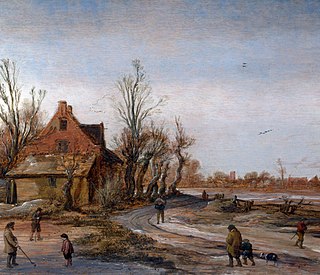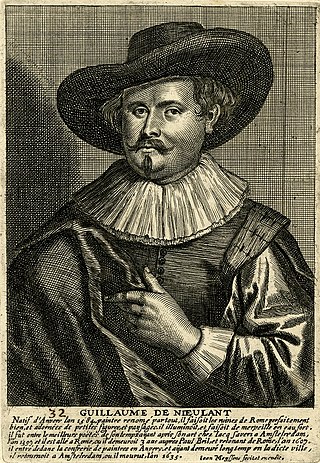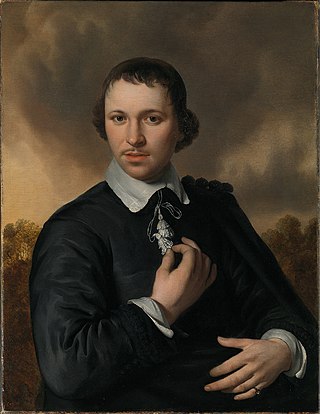
The Battle of Scheveningen was the final naval battle of the First Anglo-Dutch War. It took place on July 31st 1653 between the fleets of the Commonwealth of England and the Dutch Republic. The Dutch fleet suffered heavy losses.

Cornelis Maartenszoon Tromp, Count of Sølvesborg was a Dutch naval officer who served as lieutenant-admiral general in the Dutch Navy, and briefly as a general admiral in the Royal Danish-Norwegian Navy. Tromp is one of the most celebrated and controversial figures in Dutch naval history due to his actions in the Anglo-Dutch Wars and the Scanian War. His father was the renowned Lieutenant Admiral Maarten Tromp.

Willem van de Velde the Younger was a Dutch marine painter, the son of Willem van de Velde the Elder, who also specialised in maritime art. His brother, Adriaen van de Velde, was a landscape painter.

Ludolf Bakhuizen was a German-born Dutch painter, draughtsman, calligrapher and printmaker. He was the leading Dutch painter of maritime subjects after Willem van de Velde the Elder and Younger left for England in 1672. He also painted portraits of his family and circle of friends.

Adriaen van de Velde, was a Dutch painter, draughtsman and print artist. His favorite subjects were landscapes with animals and genre scenes. He also painted beaches, dunes, forests, winter scenes, portraits in landscapes, as well as mythological and biblical scenes. He belongs to a group of painters referred to as the Dutch Italianate painters, who combined Dutch agricultural landscapes with mythological or Arcadian scenes in Italian settings. His paintings are characterised by their delicate, careful composition and his mastery of lighting effects as well as the human figure.

Simon de Vlieger was a Dutch painter, draughtsman and designer of tapestries, etchings, stained glass windows. While he is mainly known for his marine paintings he also painted beach scenes, landscapes and genre scenes.

Esaias van de Velde was a Dutch landscape painter.

Willem van der Zaan was a Dutch Admiral. His name is often given in the 17th century spelling Zaen.

Adriaen van Trappen Banckert was a Dutch admiral. In English literature he is sometimes known as Banckers. His first name is often rendered in the modern spelling Adriaan. Van Trappen was the original family name, but the family was also and better known under the name of Banckert. In the 17th century Netherlands such a situation was solved by combining the two names.
Michael Strang Robinson (1910–1999) was Keeper of Pictures at the National Maritime Museum, London, England. He was an expert on the paintings of Willem van de Velde, the elder and Willem van de Velde, the younger.

Adriaen Hanneman was a Dutch Golden Age painter best known for his portraits of the exiled British royal court. His style was strongly influenced by his contemporary, Anthony van Dyck.
The naval history of the Netherlands dates back to the 15th century. As overseas trade was a traditional cornerstone of the Dutch economy, naval defence was indispensable for the protection of commercial interests.

Kingfisher was a 46-gun fourth-rate ship of the line of the Royal Navy, built by Phineas Pett III at Woolwich Dockyard and launched in 1675. She was specially designed to counter the attacks of Algerine corsairs, or pirates, in the Mediterranean by masquerading as a merchantman, which she achieved by hiding her armament behind false bulkheads. She also was provided with various means of changing her appearance.

Gerard Brandt was a Dutch preacher, playwright, poet, church historian, biographer and naval historian. A well-known writer in his own time, his works include a Life of Michiel de Ruyter and a Historie der vermaerde zee- en koopstadt Enkhuisen.

Engel Michielszoon de Ruyter was a Dutch vice-admiral.

Isaac Sailmaker was an etcher and marine painter of the Baroque period, who had a long career in England. He was referred to in contemporary books and journals as "the father of British sea painting", but was eclipsed by his contemporaries, the Dutch marine painters Willem van de Velde the Elder and his son Willem van de Velde the Younger, who for a period dominated the London market. Sailmaker was commissioned by the English Lord Protector, Oliver Cromwell, to paint the English fleet at Fort-Mardyck.

Guilliam or Willem van Nieulandt or van Nieuwelandt (1582/84–1635) was a Flemish painter, engraver, poet and playwright from Antwerp. He spent two thirds of his career in the Habsburg Netherlands and the remainder in Italy and the Dutch Republic. He is known for his Italianate landscape paintings and prints, often real views or capricci of landscapes and buildings from in or around Rome enlivened by contemporary figures or biblical or mythological scenes. He is regarded as the principal poet and playwright active in the Habsburg Netherlands in the first three decades of the 17th century.

Marine art was especially popular in Britain during the Romantic Era, and taken up readily by British artists in part because of Great Britain's geographical form. This article deals with marine art as a specialized genre practised by artists who did little or nothing else, and does not cover the marine works of the leading painters of the period, such as, and above all, J. M. W. Turner. The tradition of British marine art as a specialized genre with a strong emphasis on the shipping depicted began in large part with the artists Willem Van de Velde the Elder and his son, called the Younger in the early 18th century. The Van Veldes, originally from Holland, moved to England to work for King Charles II). By the 17th century, marine art was commissioned mostly by merchant seamen and naval officers and created by marine art specialists. In part, marine art served as a visual portrayal of Britain's power on the sea and as a way of historically documenting battles and the like. As British sea captains began to recognize the ability of marine artists to bring Britain's success on the sea to the public on land, some took on an active role in supporting this type of artwork. For example, marine artist Robert Cleveley was hired by Captain William Locker to work in HMS Thames as a clerk, and Captain Locker, interested in employing artists, is believed to have played a significant role in encouraging Cleveley to work as a marine painter. Captains would act as marine artists' patrons, commissioning them to paint portraits of themselves and pictures depicting important battles. A few significant marine artists who were supported in this way by naval officers are Nicholas Pocock, Thomas Luny, and George Chambers. William Hodges, for example, who was trained to draw at William Shipley's Academy, was hired by the Admiralty to finish his pictures from Cook's 1772 voyage for publication upon reaching home in 1775. Captains also commissioned artists to paint portraits of their ships.

Jan van de Cappelle was a Dutch Golden Age painter of seascapes and winter landscapes, also notable as an industrialist and art collector. He is "now considered the outstanding marine painter of 17th century Holland".

























